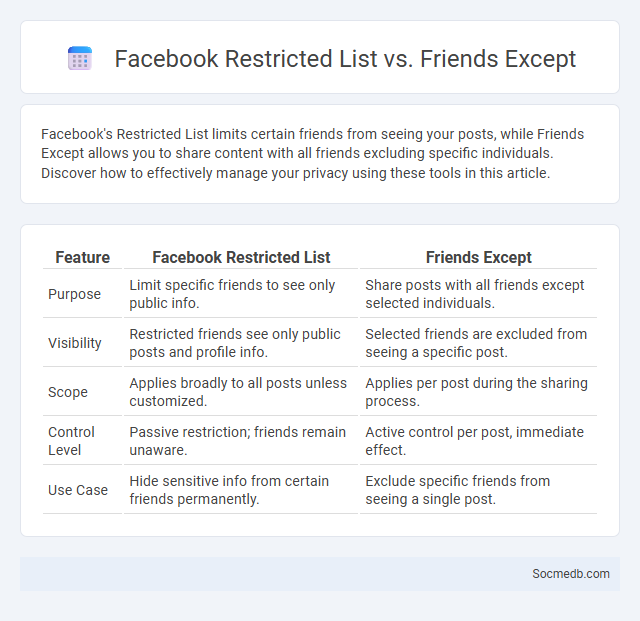
Photo illustration: Facebook Restricted List vs Friends Except
Facebook's Restricted List limits certain friends from seeing your posts, while Friends Except allows you to share content with all friends excluding specific individuals. Discover how to effectively manage your privacy using these tools in this article.
Table of Comparison
| Feature | Facebook Restricted List | Friends Except |
|---|---|---|
| Purpose | Limit specific friends to see only public info. | Share posts with all friends except selected individuals. |
| Visibility | Restricted friends see only public posts and profile info. | Selected friends are excluded from seeing a specific post. |
| Scope | Applies broadly to all posts unless customized. | Applies per post during the sharing process. |
| Control Level | Passive restriction; friends remain unaware. | Active control per post, immediate effect. |
| Use Case | Hide sensitive info from certain friends permanently. | Exclude specific friends from seeing a single post. |
Understanding Facebook Privacy Settings
Understanding Facebook privacy settings empowers you to control who can see your personal information, posts, and photos, enhancing your online security. Customizing settings like profile visibility, friend lists, and app permissions ensures your data is shared only with intended audiences. Regularly reviewing and updating these options safeguards your privacy against unauthorized access and data misuse.
What Is the Facebook Restricted List?
The Facebook Restricted List limits the visibility of your posts to specific people without unfriending them, ensuring your content remains private from those on the list. You can add friends to the Restricted List to prevent them from seeing updates unless you tag them or share posts publicly. Managing this feature helps you control your online privacy and tailor who sees your personal information on Facebook.
How "Friends Except" Works on Facebook
Friends Except" on Facebook allows you to share posts with all your friends except specific individuals you choose to exclude, enhancing your control over your audience and privacy. When you select this option, your content becomes visible to every friend on your list except those you've explicitly omitted, preventing unwanted viewers from seeing your updates. This feature enables you to tailor your social media interactions to suit your personal preferences and maintain boundaries with your contacts.
Key Differences Between Restricted List and Friends Except
Restricted List limits social media connections by allowing only public profile information to be visible, restricting private content from specific users. Friends Except enables sharing posts with all friends except selected individuals, offering more granular control over content visibility. Both features are essential for customizing privacy settings but cater to different levels of access management on platforms like Facebook.
Use Cases for the Facebook Restricted List
The Facebook Restricted List allows you to limit the visibility of your posts to selected friends without unfriending them, making it ideal for managing professional contacts or casual acquaintances. This feature helps maintain privacy by ensuring sensitive content is only visible to trusted individuals while keeping other connections intact. Utilizing the Restricted List is crucial for balancing personal sharing with network boundaries on social media.
When to Use "Friends Except
Use the "Friends Except" setting on social media to share posts with all your friends while excluding specific individuals, ensuring privacy and control over who sees your content. This feature is particularly helpful when sharing sensitive information or personal updates that you want to keep away from certain contacts. Employing "Friends Except" enhances customized audience targeting, balancing openness with selective sharing to maintain boundaries on platforms like Facebook.
Managing Your Facebook Audience
Managing your Facebook audience involves optimizing privacy settings, segmenting followers into relevant groups, and regularly analyzing engagement metrics to tailor content effectively. Utilize Facebook Audience Insights to understand demographics, behaviors, and preferences, enabling targeted advertising campaigns and improved organic reach. Consistent audience management enhances user interaction, brand loyalty, and overall social media performance.
Step-by-Step: Adding Someone to the Restricted List
Managing your social media privacy includes adding someone to the restricted list to limit their access to your posts without unfriending them. You start by navigating to the person's profile, clicking on the "Friends" or "Following" dropdown menu, and selecting "Add to Restricted List." This ensures your posts shared only with friends remain hidden from them while maintaining your social connection.
Step-by-Step: Using "Friends Except" in Posts
Using the "Friends Except" feature on social media allows you to share posts with your network while excluding specific friends or groups. You can customize your privacy settings by selecting the "Friends Except" option before posting, ensuring that those you exclude won't see your content. This approach helps tailor your audience for each post, protecting your privacy and controlling who views your shared information.
Which Privacy Option Is Right for You?
Choosing the right social media privacy option depends on your desired level of information sharing and control over personal data. Platforms like Facebook, Instagram, and Twitter offer settings such as public, friends-only, and private accounts to manage visibility and limit data exposure. Regularly reviewing privacy policies and updating preferences helps safeguard personal information against unauthorized access and online threats.
 socmedb.com
socmedb.com